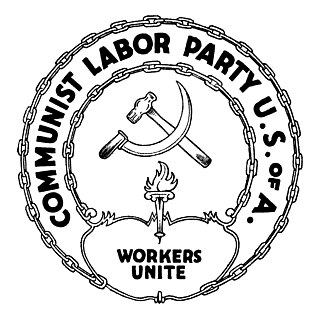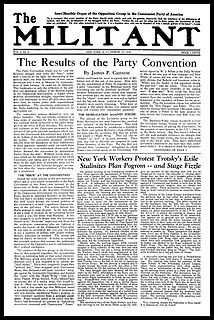Related Research Articles
Max Shachtman was an American Marxist theorist. He went from being an associate of Leon Trotsky to a social democrat and mentor of senior assistants to AFL-CIO President George Meany.

Martin "Marty" Abern (1898–1949) was a Marxist politician who was an important leader of the Communist youth movement of the 1920s as well as a founder of the American Trotskyist movement.

The Communist Labor Party of America (CLPA) was one of the organizational predecessors of the Communist Party USA.
The New International is a magazine of Marxist theory published first by the Socialist Workers Party of the United States (SWP) from 1934 to 1940, then by the Workers Party from 1940 to 1958, and then revived by the SWP since 1983.

The Socialist Propaganda League of America (SPLA) was established in 1915, apparently by C.W. Fitzgerald of Beverly, Massachusetts. The group was a membership organization established within the ranks of the Socialist Party of America and is best remembered as direct lineal antecedent of the Left Wing Section of the Socialist Party and its governing National Council — the forerunner of the American Communist movement.

Benjamin "Ben" Gitlow was a prominent American socialist politician of the early 20th century and a founding member of the Communist Party USA. During the end of the 1930s, Gitlow turned to conservatism and wrote two sensational exposés of American Communism, books which were very influential during the McCarthy period. Gitlow remained a leading anti-communist up to the time of his death.

The Workers' Council of the United States -- commonly known as the "Workers' Council" -- was a short-lived organized faction of former Socialist Party of America members seeking to affiliate with the Comintern. Failing that, they agitated for the creation of an open communist party. While a small and short-lived group, it nevertheless played an important role in the 1921 creation of the Workers Party of America, and included many individuals who would have prominent careers in radical and labor movements such as Moissaye Olgin, J. Louis Engdahl, Alexander Trachtenberg, William F. Kruse, and Melech Epstein.

The Communist League of Struggle (CLS) was a small communist organization active in the United States during the 1930s. Founded by Albert Weisbord and his wife, Vera Buch, who were veterans of the Left Socialist movement and the Communist Party USA, the CLS briefly affiliated with Leon Trotsky independently of the Communist League of America. It was affiliated to the International Bureau of Revolutionary Youth Organizations until 1935. The small group dwindled and quietly was terminated in the spring of 1937.
Edward Hugo Oehler (1903–1983) was an American communist.
The Leninist League was a communist political party in the United States. It published a newspaper called "In Defense of Bolshevism".
The Marxist Workers League was the name of two splinter groups from the Revolutionary Workers League in the 1930s.
The Fieldites were a small leftist sect that split from the Communist League of America in 1934 and known officially as the Organizing Committee for a Revolutionary Workers Party and then the League for a Revolutionary Workers Party. The name comes from the name of its leader B.J. Field.
The Revolutionary Marxist League was a small Communist sect that existed from 1938 to 1939 or 1940 in New York City. It was led by Meldon Joerger and Attilio Salemme.
The Rummagers League was the final name of a small communist group that existed in the United States from 1919 to 1920.
The Workers Communist League or Gitlowites were a Right Opposition Communist group that split from the main group of the American Right Opposition, the Communist Party of the USA (Opposition) in 1933. It was the only split from that organization that created a new group.

The Revolutionary Age was an American radical newspaper edited by Louis C. Fraina and published from November 1918 until August 1919. Originally the publication of Local Boston, Socialist Party, the paper evolved into the de facto national organ of the Left Wing Section of the Socialist Party which battled for control of the Socialist Party throughout the spring and summer of 1919. With the establishment of the Left Wing National Council in June 1919, the paper was moved from Boston to New York City gained status as the official voice of the nascent American communist movement. The publication was terminated in August 1919, replaced by the official organ of the new Communist Party of America, a weekly newspaper known as The Communist.
The Workers Party (WP) was a Third Camp Trotskyist group in the United States. It was founded in April 1940 by members of the Socialist Workers Party who opposed the Soviet invasion of Finland and Leon Trotsky's belief that the USSR under Joseph Stalin was still innately proletarian, a "degenerated workers' state." They included Max Shachtman, who became the new group's leader, Hal Draper, C. L. R. James, Raya Dunayevskaya, Martin Abern, Joseph Carter, Julius Jacobson, Phyllis Jacobson, Albert Glotzer, Stan Weir, B. J. Widick, and Irving Howe. The party's politics are often referred to as "Shachtmanite."

The Communist League of America (Opposition) was founded by James P. Cannon, Max Shachtman and Martin Abern late in 1928 after their expulsion from the Communist Party USA for Trotskyism. The CLA(O) was the United States section of Leon Trotsky's International Left Opposition and initially positioned itself as not a rival party to the CPUSA but as a faction of it and the Comintern. The group was terminated in 1934 when it merged with the American Workers Party headed by A. J. Muste to establish the Workers Party of the United States.

The Revolutionary Workers League (RWL) was a radical left group in the United States, lasting from 1935 through 1946. It was led by Hugo Oehler and published The Fighting Worker newspaper.

James Patrick Cannon was an American Trotskyist and a leader of the Socialist Workers Party.
References
- ↑ "Footnote for Historians" by Max Shachtman in New International, Vol.4 No.12, December 1938, pp.377-379
- ↑ Creative Communism worldcat entry
- ↑ Goldwater, Walter Radical periodicals in America 1890-1950 New Haven, Yale University Library 1964 p.36